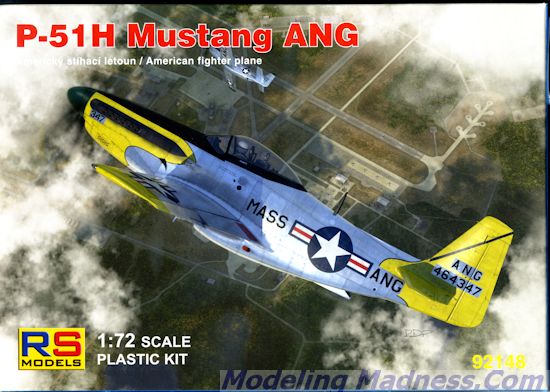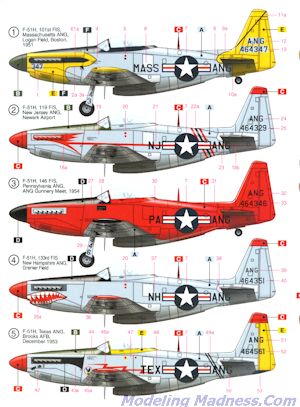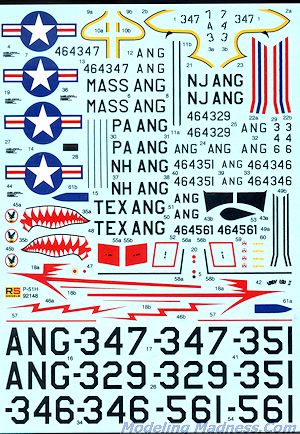
RS Models 1/72 P-51H Mustang
| KIT #: | RS 92148 |
| PRICE: | 2610 yen from Hobbylink Japan (about $25.00) |
| DECALS: | Five options |
| REVIEWER: | Scott Van Aken |
| NOTES: | Includes resin parts |

| HISTORY |
The P-51H (NA-126) was the final production Mustang, embodying the experience gained in the development of the XP-51F and XP-51G aircraft. This aircraft, with minor differences as the NA-129, came too late to participate in World War II, but it brought the development of the Mustang to a peak as one of the fastest production piston-engine fighters to see service.
The P-51H used the new V-1650-9 engine, a version of the Packard-built Merlin that included Simmons automatic supercharger boost control with water injection, allowing War Emergency Power as high as 2,218 hp (1,500 kW). Differences between the P-51D included lengthening the fuselage and increasing the height of the tailfin, which greatly reduced the tendency to yaw. The canopy resembled the P-51D style, over a raised pilot's position. Service access to the guns and ammunition was also improved. With the new airframe several hundred pounds lighter, the extra power and a more streamlined radiator, the P-51H was among the fastest propeller fighters ever, able to reach 487 mph (784 km/h or Mach 0.74) at 25,000 ft (7,600 m).
The P-51H was designed to complement the P-47N as the primary aircraft for the invasion of Japan, with 2,000 ordered to be manufactured at Inglewood. Production was just ramping up with 555 delivered when the war ended.
Additional orders, already on the books, were canceled. With the cutback in production, the variants of the P-51H with different versions of the Merlin engine were produced in either limited numbers or terminated. These included the P-51L, similar to the P-51H but utilizing the 2,270 hp (1,690 kW) V-1650-11 engine, which was never built; and its Dallas-built version, the P-51M, or NA-124, which utilized the V-1650-9A engine lacking water injection and therefore rated for lower maximum power, of which one was built out of the original 1629 ordered, serial number 45-11743.
Although some P-51Hs were issued to operational units, none saw combat in World War II, and in postwar service, most were issued to air national guard units. One aircraft was provided to the RAF for testing and evaluation. Serial number 44-64192 was designated BuNo 09064 and used by the U.S. Navy to test transonic airfoil designs and then returned to the Air National Guard in 1952. The P-51H was not used for combat in the Korean War despite its improved handling characteristics, since the P-51D was available in much larger numbers and was a proven commodity.
Many of the aerodynamic advances of the P-51 (including the laminar flow wing) were carried over to North American's next generation of jet-powered fighters, the Navy FJ Fury and Air Force F-86 Sabre. The wings, empennage and canopy of the first straight-winged variant of the Fury (the FJ-1) and the unbuilt preliminary prototypes of the P-86/F-86 strongly resembled those of the Mustang before the aircraft were modified with swept-wing designs.
| THE KIT |
 The P-51H has been fairly well represented in both scales. In 1/48, there were two short run kits by HiPM and Classic Airframes, for which build articles of both can be found in the archives. In 1/72, kit were produced by Beechnut, CMR, and Model News. Of these, the CMR resin kit is by far the best. Now RS Models has joined the group and while not as detailed as the CMR kit, is mostly injected plastic so much more 'user friendly' if one is not comfortable building resin kits.
The P-51H has been fairly well represented in both scales. In 1/48, there were two short run kits by HiPM and Classic Airframes, for which build articles of both can be found in the archives. In 1/72, kit were produced by Beechnut, CMR, and Model News. Of these, the CMR resin kit is by far the best. Now RS Models has joined the group and while not as detailed as the CMR kit, is mostly injected plastic so much more 'user friendly' if one is not comfortable building resin kits.
The Mustang is a pretty basic aircraft and so RS Models' kit is not all that complex. There are two sprues of nicely detailed plastic along with a few resin parts. The cockpit is made up of a seat, control stick, armor plate, radio piece, floor and rear bulkhead. There are two resin rudder pedals and an instrument panel. Sidewall detail is also molded into the fuselage halves. Unfortunately, any work at detailing the cockpit will be difficult to see as the one-piece canopy is quite thick.
There is a nicely done ventral intake ductwork with radiator. The forward ventral intake is two pieces so there will be a lip seam to deal with. The tail gear is actually three pieces and includes the retraction mechanism and support struts. The main gear well is a separate piece and fits into the one piece lower wing.
For things under wings one can install bombs on their racks and also rockets. The rocket stubs are molded onto the rockets. There are placement markings for the racks and stubs molded onto the bottom of the wing. The kit  prop assembly consists of a one-piece propeller with a two-piece spinner. I should mention that resin is used for the wheels, rudder pedals, rockets, bombs
prop assembly consists of a one-piece propeller with a two-piece spinner. I should mention that resin is used for the wheels, rudder pedals, rockets, bombs and the very fine bits used on the tail gear. These latter bits are on a thick wafer so will require care in removing.
and the very fine bits used on the tail gear. These latter bits are on a thick wafer so will require care in removing.
Instructions are fairly well done and provide generic paint references. There are five markings options, most of which are unpainted metal and all are ANG planes. The painting and markings guide is on the back of the box. First is the box art plane with the 101 FIS, Massachusetts ANG in 1951. The decal sheet provides the basic form of the yellow areas. Next is a 119 FIS, New Jersey ANG plane with red trim and a nice red cheatline marking. An all red plane from the 146 FIS, Pennsylvania ANG in 1954 is next. This plane was used at a gunnery meet. The shark mouth Mustang from the 133 FIS, New Hampshire ANG is the net one. This also has red trim. Finally, a Texas ANG plane with red spinner, fin tip and wing tips with yellow rudder and canopy trim rounds out the options. There are enough data markings to do one of the five options. The sheet itself looks to be very nicely done and I did not notice any registration issues.
| CONCLUSIONS |
| REFERENCES |
http://en.wikipedia.org/wiki/North_American_P-51_variants
September 2014
My thanks to Hobbylink Japan for the preview kit. Get yoursat this link.
Back to the Previews Index Page